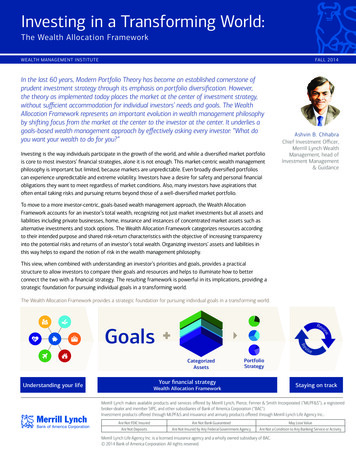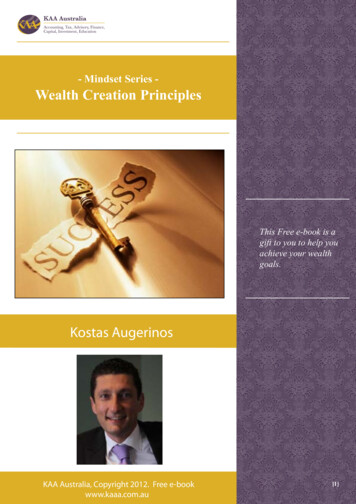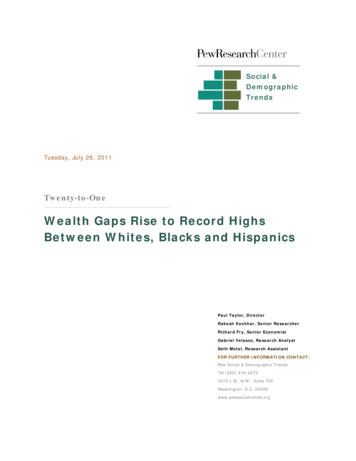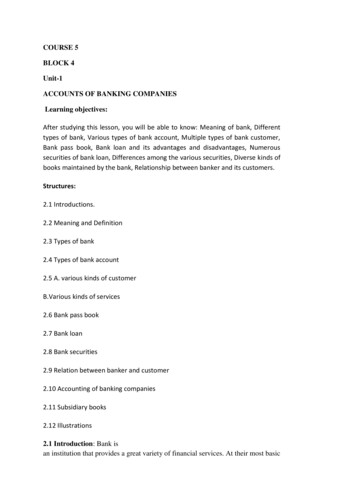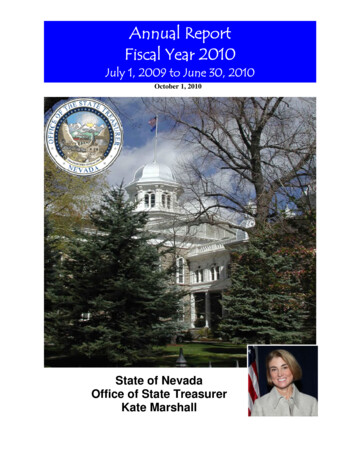
Transcription
WEALTH BUILDINGand COLLEGE SAVINGSWhat do other high school students know about wealth building?We asked high school students what they would do with an extra 5,000.I’d either buy a used car or put it in thebank so it can grow.Junior, Michigan“I would put half in long termsavings, 2,000 in a collegefund, and spend 500.”Senior, Wyoming“I’d put half in a mutual fund, 1,000 in savings, 1,000 ina money market, and buy agaming system with the rest.”Senior, Missouri“I would save it until I was 18,then put a down payment on ahouse and rent it for profit.”Senior, Texas“Save 3,500 and shop withthe rest.”Junior, AlabamaLearningOutcomesExplain what ismeant by “taxfavored dollars.”List the differenttypes of retirementplans.Differentiatebetween atraditional andRoth IRA.Illustrate how a401(k)companymatch works andprioritize moneyinto variousinvestments.Describe howpre-tax andafter-taxinvestments work.Key terms401(k)ESAIRAPre-TaxRolloverRoth IRATax-Favored Dollars31Sponsored by:
before you beginWhat do you know about Wealth Building and College Savings?Before you watch the lesson on Wealth Building and College Savings, think about what you already know.The word bank below contains some of the bigger concepts that you will learn in this lesson. Completethe first two columns before watching Dave’s lesson as you work through the chapter. Fill in the lastcolumn with the details you learned.I think I know:I want to know:What I learned:401(k)Roth IRAESAUTMA/UGMABefore TaxAfter TaxRule of 72Pension32 Foundations in Personal FinanceSponsored by:
Wealth Building and college savingsRetirement and College FundingOnce the emergency fund is in place, you should beginretirement and college funding, which falls within longterm investing for .Baby Step 1 is in the bank.Baby Step 2 is .Baby Step 3 is months of expenses in anemergency fund.Baby Step 4 is investing 15% of your householdincome into Roth IRAs and pre-tax retirement plans.Invest % of your household income into Roth IRAsand pre-tax retirement plans.Tax-favored means that the investment is in aor has a special tax treatment.The FederalDeposit InsuranceCorporation (FDIC)is responsiblefor insuring orguaranteeingdeposits in banks andsavings institutionsup to 250,000.It was created in1933 to restorepublic confidenceafter thousandsof banks failed.The FederalReserve—sometimescalled “The Fed”—isthe central bankingsystem of the UnitedStates and hasfour main duties:1. It carries out thenation’s monetarypolicies by managingthe supply of money.2. It supervises andregulates bankinginstitutions.3. It maintainsthe stability of thefinancial system.4. It provides financialservices to banks.Chapter 3: Wealth Building and College Savings 33Sponsored by:
Qualified Plans“I paid over 200 for asnowboard becauseI loved the design.I never even usedit once because itturned out to betoo small.” Individual Retirement Arrangement ( ) Simplified Employee Pension Plan ( ) 401(k), 403(b), 457Senior, Wyoming“I bought a guitarwhen I should havepaid for myspeeding ticket.”Senior, Florida“I saved up to buyan expensive hairstraightener only tofind my old, cheapstraightener workedway better.”Individual Retirement ArrangementsWhen it comes to IRAs, everyone with anincome is eligible.The maximum annual contribution for income earners is as of 2008.Junior, MissouriRemember: IRA is not a type of at a bank.It is the tax treatment on virtually any typeof investment.Roth IRAThe Roth IRA is an -tax IRA that grows tax .The Roth IRA isnamed for SenatorWilliam Roth of Delaware, who authoredthis section of theTaxpayer Relief Actof 1997.Why the Roth IRA?The Roth IRA has more .Higher at retirement.34 Foundations in Personal FinanceSponsored by:
Investing 5,000 pre-tax is different than investing 5,000 tax. It takes more than 5,000 to gethome with 5,000 after tax. It would take .There are no taxes when you cash it out, so it forces youto more.The average graduateof a four-year collegehas student loandebt of 19,237.Graduate students pileon even more studentloan debt, ranging up to 114,000.Miles To GoIt has tons of .Nearly half of allAmericans (46%) haveless than 10,000saved for retirement.Who Is Eligible:Miles To Go37% of teens notice Singles—100% contribution with income less than 95,000. Phase out between 95,000- 110,000.Not eligible above 110,000. Married filed jointly—100% contribution withincome less than 150,000. Phase out between 150,000- 160,000. Not eligible over 160,000.their parents beingconcerned aboutretirement.Charles Schwab SurveyOnly 13% of teensknow what a 401 (k)plan is.Charles Schwab Survey29% of teens feelknowledgeable aboutknowing how to payfor college.Charles Schwab SurveyFlexibility of a Roth IRA: Tax-free and penalty-free withdrawals at any timeequal to contributions. After the emergency fund isdepleted, you have a fall back.49% of teens saythey’re concernedtheir parents/guardians will not beable to support themfinancially if theyattend college.Charles Schwab Survey After five years, you can make tax-free, penaltyfree withdrawals for 100% under these conditions:1. Over 59 and a half years oldChapter 3: Wealth Building and College Savings 35Sponsored by:
2. Because of death or disability3. First-time home purchase(max 10,000)END OF VIDEO PART 1Simplified Employee Pension Plan (SEPP)A -employed person may deduct up to %of their net profit on the business by investing in a SEPP. The maximum deductible amount is 45,000 (as of2007) and all employees who have been with the firmmore than three of the last five years must receive thesame percentage of their pay into a retirement plan.Winning the lotterydoes not guaranteepeace of mind whenit comes to yourfinancial future. Infact, Ellen Goodsteinof bankrate.comreported that just theopposite happenedto some lotterywinners—theywent broke.Saving and investinghave nothing to dowith the amount ofmoney you make orget. It is about makingit a priority andbeing smart withyour money.William Post won 16.2 million from the Pennsylvania Lottery in 1988 His former girlfriend sued him and won a share of his winnings. His brother was arrested for hiring a hit man to kill him, hoping to inheritthe winnings. His other siblings harassed him until he invested in a car business and restaurant, both of which failed. He was 1 million in debt just one year later. Ultimately, he declared bankruptcy and now lives on food stamps.Willie Hurt won 3.1 million from the Michigan Lottery in 1989 He spent his money on a divorce and crack cocaine. Two years later, he was broke and facing murder charges.Suzanne Mullins won 4.2 million from the Virginia Lottery in 1993 She borrowed 197,746, using her lottery winnings as collateral. She stopped making payments on the loan after she collected the rest of herwinnings in a lump sum. The company Suzanne borrowed the money from won a judgment against herfor 154,147, but has never seen a dime. Today, she has no assets.36 Foundations in Personal FinanceSponsored by:
401(k), 403(b) & 457 Retirement PlansMost companies have completely done away withtraditional plans.It has been replaced by self- andplans, like the 401(k). The 401(k) is yours, unlike the pension plan whichwas an asset of the company. If the company wentbroke, you most likely lost your pension. If you don’t put money into a 401(k) there will benothing in the fund. A pension, however, is fundedautomatically by your company.The 403(b) is found in non-profit organizations such aschurches, hospitals and schools.The 457 is compensation, which meansyou are deferring or putting off compensation. Usuallythis is available for government employees.The Rule of 72 isa quick way to docompound interestproblems in yourhead. It isn’t exact,but it will give you aquick benchmark tosee how long it willtake to double yourmoney at a giveninterest rate.The Rule of 72 saysthat by dividing theinterest rate into72, it will tell youapproximately howmany years it willtake to doubleyour money.Example: How longwill it take to doubleyour money at 12%?72/12 6 yearsWhat interest ratedo I need to earn ifI want my money todouble in 7 years?72/7 10.28%Do not use a Investment Contract(GIC) or bond funds to fund your plan. This is like a C.D. inside of your 401(k). You will onlymake about 3-4% and it will not help you win long-term.You should be funding your plan whether your companyor not.Chapter 3: Wealth Building and College Savings 37Sponsored by:
RolloversImagine if a couple,who are both 30 yearsold, funds a Roth IRA( 500 per month) at12% interest. At 70years old theywill have. 5,882,386.26, taxfree!Imagine if that samecouple made 40,000and saved 15% in a401 (k) (that’s 500per month or 6,000per year) at 12%interest. At 70 yearsold they will have. 5,882,386.26,tax free!You should always over retirement plans to anwhen you leave the company.Don’t bring the money home, instead, move it straightinto an IRA by a .Roll to a Roth Only If:1. You will have over 700,000 by age 65.2. You can afford to pay the separately, notfrom the IRA.By the time theyretire at age 65, thatcouple’s 1,000 permonth savings in IRAsand 401(k)s will growto: 11,764,772.513. You understand all will become due on theEND OF VIDEO PART 2rollover amount.Retirement LoansNever on your retirement plan. NEVER!Federal Thrift PlanFor federal government workers who have the standardthrift plan, we recommend 60% in the C fund, 20% in theS fund, and 20% in the I fund.38 Foundations in Personal FinanceSponsored by:
Baby Step 4Invest 15% of household income into Roth IRAs andpre-tax retirement.1. Fund 401(k) or other employer plan up to the. (If applicable)2. Above the match, fund IRAs. If thereis no match, start with Roth IRAs.3. Complete 15% of income by going back to yourEND OF VIDEO PART 3or other company plans.There are no fill-in-the-blanks for Part 4.END OF VIDEO PART 4Scholarships aren’tjust for the highestscorers on the ACTor SAT. Schools andfoundations havebroadened their criteria to include community involvement,after-school workand financial status inaddition to the traditional athletics and diversity scholarships.Don’t avoid the scholarship applicationsrequiring essays. It isa good way to improveyour writing skillswhile earning scholarships. Here aresome additional resources to look into.1. Talk to yourguidance counselor.College Funding2. Explore your state’swebsite.Save for your children’s education usingtax-favored plans.First.Save for college by first using Educational SavingsAccounts (ESA), nicknamed “Education .”You may save 2,000 (after tax) per year, per child, thatgrows tax free! So, if you start when your child is bornand save 2,000 a year for 18 years, you would onlyinvest a total of 36,000. However, at 12% growth, yourchild would have 126,000 for college—TAX FREE!3. Many businesseshave scholarships foremployee’s children.Ask your parents tocheck at their place ofemployment.4. Explore the federalgovernment’s websiteat studentaid.ed.gov5. Check out the bigcollege organizationsfor information(collegeboard.com,petersons.com).6. Apply forscholarships withlocal organizationssuch as Rotary Clubs.Chapter 3: Wealth Building and College Savings 39Sponsored by:
“I am 22 and I’ve been thinking about going back to school.My employer is willing to pay for nine credit hours persemester, but if I take more than nine hours they won’t payanything. My parents think we should get student loans.What do you think?”DAVE’S ANSWER: I’m sure your parents are good people. And I knowthey don’t mean any real harm. They’re just being normal, but in today’s culture normal is broke. They’ve probably been around studentloans, car payments and credit cards all their lives, and that’s sad.Go for it! You have a great opportunity staring at you. I mean, how manytimes does someone offer to pay for your degree with no financialstrings attached? You couldn’t take much more than nine hours persemester and still work a full-time job anyway.Above that If you want to save more or if you don’t meet the incomelimits for an ESA, use a certain type of plan.Never buy a plan that:1. your options.2. Automatically changes your investments basedon the of the child.Only then Move to an or plan. While this is one way to save with reduced taxes, itis as good as the other options. UTMA/UGMA stands for Uniform /Gift to Act.40 Foundations in Personal FinanceSponsored by:
The account is in the child’s nameand a is named, usually the parent orgrandparent. This person is the manager until thechild reaches age 21. At age 21 (age 18 for UGMA),they can do with it what they please.You don’t have to geta student loan to goto college. There aremany other ways topay for higher education besides going intodebt. Consider theseoptions instead: Work while goingthrough schoolThree “Nevers” of College Savings Get a job oncampusNever save for college using . Join the militaryNever save for college using bonds. (Only earns 5-6%)Never save for college using tuition.An ESA is not the right savings vehicle if you needthe money within five years. Use a money marketEND OF VIDEO PART 5mutual fund. Find a job wherethey will pay foryour schooling(ie: UPS) Go to school instate as opposedto out-of-state Go to a publicschool instead ofa private school Get your coreclasses at alocal communitycollege, thengo to a 4-yearinstitutionRecap and ReviewSave long-term in tax favored plans—a Roth IRA grows tax-free.Contribute to your 401(k), especially when a match is offered.Do not sign up for investment plans that you don’t understand.NEVER borrow on your retirement plan.You do not have to get a student loan to go to college! Live at homewhile going tocollege Get a degreein a field thatwill help pay foryour college (ie:teachers mightqualify for tuitiongrants as longas they agreeto teach for 3 ormore years)Chapter 3: Wealth Building and College Savings 41Sponsored by:
Chapter 3: Money in ReviewVocabulary401(k)403(b)457 Plan529 PlanCustodianDirect TransferESAIRAPre-Paid TuitionRolloverRoth IRASEPPTax-Favored th IRASEPP1. Retirement plan for self-employed people2. Grows tax-free3. The typical retirement plan found inmost corporations4. Used for college savings5. The typical retirement plan found innon-profit groups such as schoolsand hospitalsTrue/False6. Pre-tax means the government is letting you invest money before taxeshave been taken out.7. Savings bonds are a good way to savefor college.8. Never borrow money from yourretirement plan.9. When you leave a company, don’t moveyour money from the retirement account.10. An IRA is a specific type of investment.Multiple Choice11. The IRA grows tax-free.a. Rothb. traditionalc. originald. life insurance12. An Educational Savings Account (ESA) isused for .a. retirementb. collegec. an emergency fundd. a new car13. Which of the following is not a retirement plan?a. 529b. 401(k)c. 403(b)d. 45742 Foundations in Personal FinanceSponsored by:
14. Which is not a benefit of the Roth IRA?a. grows tax-freeb. unlimited contributionsc. provides penalty-free withdrawals undercertain circumstancesd. more choices15. If your company provides a 100% matchup to 6%, how much should you personallycontribute to your 401(k) if you earn 35,000 (not including the money thecompany contributed)?a. 1,750b. 2,100c. 3,500d. 5,25016. If you contribute 2,300 to your 401(k)and your company matches up to 3%, howmuch is in the account (assume you havenot gone over the 3% match)?a. 1,150b. 2,300c. 4,600d. 6,90017. What should you do with your retirementaccounts when you leave a company?a. cash them outb. fund depositc. fund shiftd. direct transfer18. Never save for college using:a. pre-tax dollarsb. pre-paid tuitionc. savings bondsd. both b and c19. Baby Step 5 is:a. 3-6 months of expenses savedb. college fundingc. 15% of household income intoretirement plansd. the debt snowball20. If Carol and Joe are debt free, how muchshould they be investing in retirement plansif their combined income is 145,000?a. 14,500b. 21,000c. 21,750d. 43,500Short Answer21. What are the advantages of a Roth IRA?22. What is Baby Step 4 and why does youremergency fund have to be fully fundedbefore you begin this step?23. List some ways you can avoid student loandebt if you do not have a college fund.24. Why should you take a 401(k) match (if acompany offers one) before you starta Roth IRA?25. Explain what is meant by tax-favored dollars.26. Why worry about retirement when everyworker pays into Social Security?27. Explain how the rule of 72 works.Case Studies28. Courtney and Joe have been saving fortheir two son’s college (age 17 & 15)and now have 16,000 in each account.However, the money is in a savingsaccount. They recently started listening toDave and realized that is not where theirmoney should be. Does Dave advise themto move the money and if so, where?Chapter 3: Wealth Building and College Savings 43Sponsored by:
29. Jane makes 85,000 at her current job.Her company matches 100% up to 3% and50% up to 6%. Jane is currently fundingher 401(k) at only 10% although she iscompletely debt free. What does Dave tellher to do for retirement? (Break it down interms of how much she should be investingtotal, what the company is matching, andwhere to put her investments.)30. Austin and Kayla have 35,000 in debt(student loan, credit cards, car loan) buthave cut up all of their credit cards andstarted their debt snowball. Austin justgot a substantial raise and their householdincome is now 125,000 ( 3,500 more permonth, net). Should he cash out his 401(k)which has about 25,000, pay off his debt,and start again from square one? Explainyour answer.44 Foundations in Personal FinanceSponsored by:
Chapter 3: Wealth Building and College Savings 39 Baby step 4 Invest 15% of household income into Roth IRAs and pre-tax retirement. 1. Fund 401(k) or other employer plan up to the _. (If applicable) 2. Above the match, fund _IRAs. If there is no match, start with Roth IRAs. 3. Complete 15% of income by going back to your



